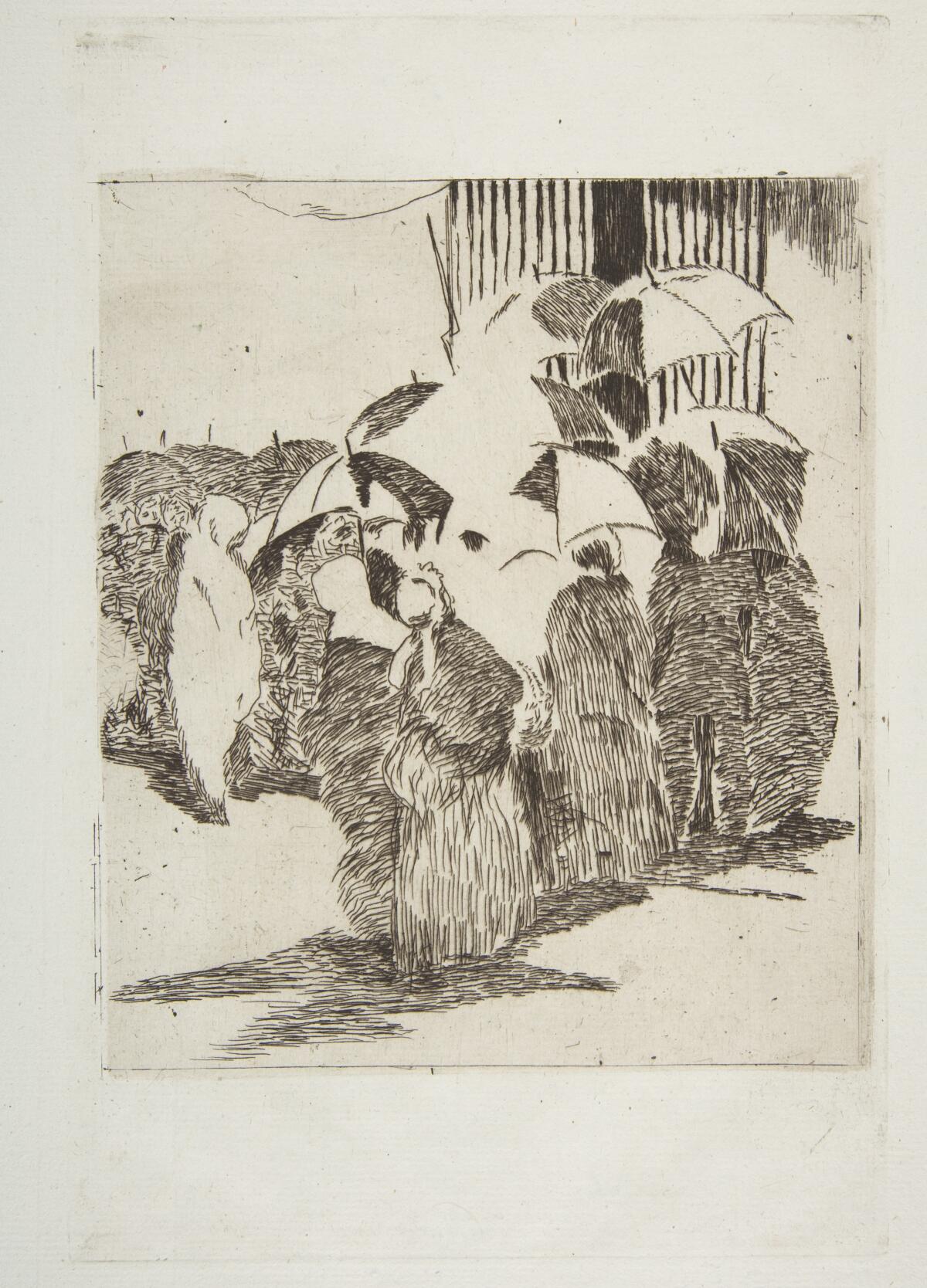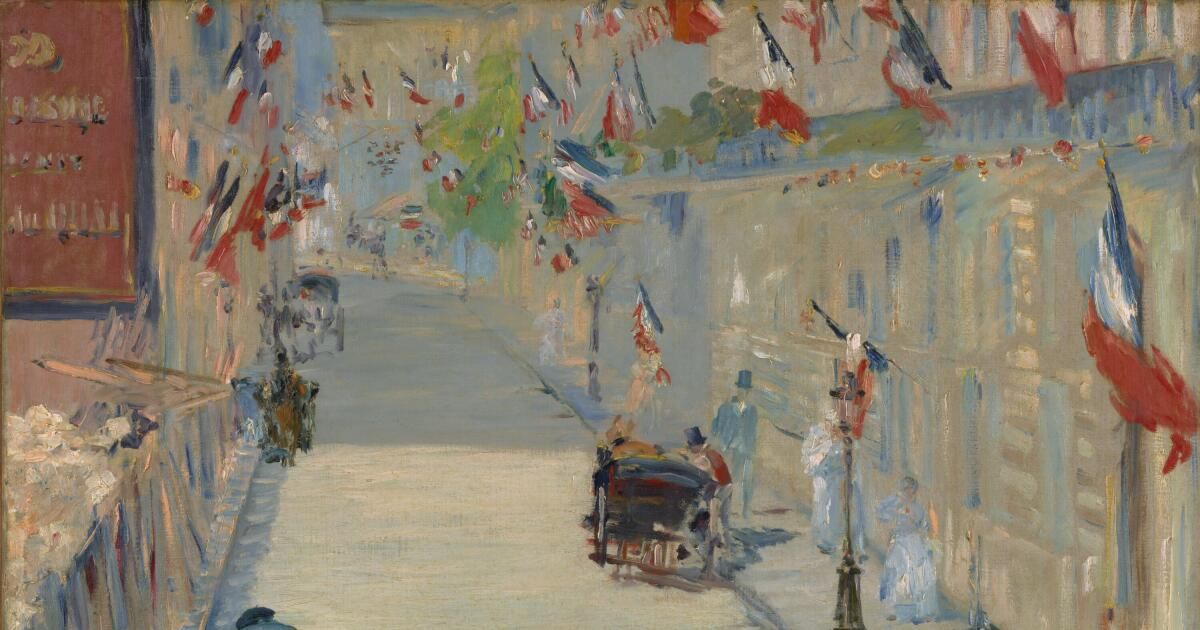Book review
Paris in Ruins: Love, War and the Birth of Impressionism
By Sebastian Smee
Norton: 384 pages, $35
If you purchase books linked on our site, The Times may earn a commission from Bookshop.org, whose fees support independent bookstores.
Book review
Monet: The restless vision
By Jackie Wullschläger
Knopf: 576 pages, $45
If you purchase books linked on our site, The Times may earn a commission from Bookshop.org, whose fees support independent bookstores.
The revolution was in the outdoorsBy the reign of Napoleon III, the Second French Empire had extensively colonized abroad and modernized at home, with the construction of the boulevards of Paris and the glorious rise of the city as a world capital of culture and fashion. The empire had brought stability to France after decades of bloodshed and tumult, but republican passions still stirred, particularly among the intellectual and political elites. gentry.
What happened on the road to rebellion? This year marks the sesquicentennial of the first Impressionist show in 1874, and two exquisite books have arrived to mark the occasion. While they differ in scope, both are elegant, fluid, and resonant contributions to art history.
Jackie Wullschläger, a critic for the Financial Times, has written a sumptuous biography of Claude Monet, the master of the movement, describing the innovation that lay beneath its surfaces. “Monet: The Restless Vision” spans the painter’s long life and career, a portrait of a mercurial and materialistic artist, ambitious and vain but generously loyal to all those around him. The author traces his middle-class origins as a child and teenager in the coastal town of Le Havre, where his eternal muse lived. He chose a less lucrative profession, subsidized by a beloved aunt and wealthy friends, such as Édouard Manet. In the 1860s he gravitated toward Manet’s circle in Paris: Degas, Bazille, Cézanne, Berthe Morisot, Pissarro and Renoir. These painters, who became stars of museums and private collections, supported each other during the lean months: those who had helped those who had not, united in their dislike of the stale and imperious criteria of the Salon (Monet came to own fourteen Cézanne canvases).

When the Franco-Prussian War began, Monet moved to London, where he remained aloof from hostilities, palette in hand. Upon his return to France, he and his colleagues worked outdoors, often setting up their easels side by side. Monet relied on his first wife, Camille, as his primary model; she posed as four distinct figures in his early “Women in the Garden” (1866). “The Port at Argenteuil” (1874), Wullschläger observes, is “a beacon of the early Impressionist moment. Unified, each part with the others, inviting the eye to enter and linger anywhere, satisfying in its decorative ensemble of forms, the arabesques of the trees echoing the shapes of the clouds, it evokes a harmonious atmosphere quite different from the stark depiction of the broken bridge a few months earlier.”
Following Camille's prolonged illness and death in 1879, Monet met Alice Hoschedé, the former wife of a department store magnate whose death allowed the couple to marry, merging their families into a kind of bohemian Brady Bunch. Their villa at Giverny remained his base of operations throughout his life.

Jackie Wullschläger, author of “Monet: The Restless Vision.”
(William Cannell)
As the century progressed, Monet became bolder, embarking on several series of subjects depicted at different times of day, in different shades of light. Wullschläger singles out Haystacks as a breakthrough, insisting on “the contemplation of that passing moment, of the transience of all moments.” He writes: “The short, choppy strokes produce waves of colour in multiple layers, suggesting light as a pulsating force, but merging into an opalescent haze when viewed from a distance.” Against a backdrop of postwar comfort, new ways of seeing emerged.
Wullschläger avoids attempting exhaustive description; why burden his book with gratuitous detail? He prefers to delight, saving the best for last: his in-depth study of Monet’s magnificent water lilies (he called them “Grandes Décorations”), a riot of brushstrokes that fuse representation and abstraction, foreshadowing future titans like Pollock and de Kooning. “The Grandes Décorations have the hallmarks of a late style: extreme, abstract, interior,” notes Wullschläger, “at the same time the crowning achievement of Impressionism, eloquent paintings… the compositions everywhere speak of chaos and dissolution.” Despite his loss of sight, Monet continued to work until his death in 1926.

Sebastian Smee, author of “Paris in Ruins.”
(Amber Davis Tourlentes)
Sebastian Smee, the Pulitzer Prize-winning critic for the Washington Post, departs from Wullschläger’s approach in his vibrant and incisive “Paris in Ruins,” focusing on those crucial years just before that initial exhibition, when the Franco-Prussian War toppled the Second Empire and gave rise, in fits and starts, to the French Third Republic. At the heart of the book is the romance between Édouard Manet, married, and the talented Berthe Morisot, single and living with her parents in the fashionable suburb of Passy. Manet had galvanized the most inventive (and disruptive) painters and writers, drawing them like a magnet. “He was like the director of an amateur theater company made up of friends, family and anyone else he could attract,” Smee opines. “They wore their assigned costumes with varying degrees of conviction, addressing an audience that was supposed to be in on the game.”

“Queue in front of the butcher’s shop” by Édouard Manet.
(Courtesy of Norton)
Manet’s fascination with Morisot first manifested itself in his homage to Goya, The Balcony (1868-69). Paris in Ruins brims with delightful anecdotes: the elegant gatherings of the Morisots; the military duty imposed on eligible men; the hot-air balloons and carrier pigeons that preserved the city’s communication with the world. With a treaty on the table, in which Napoleon would surrender and end the Franco-German War, civil war broke out in France, pitting leftists against moderates in collusion with the German leader. Smee’s recreation of this complicated moment and the insurrection it unleashed is a superb and chilling narrative, culminating in the Bloody Week of May 1871, which produced thousands of civilian casualties, random executions and the burning of iconic institutions.
As the City of Light burned, this group of artists turned to quiet landscapes and domestic scenes that exalted bourgeois values. Theirs, however, was an insurgency. “The absence of hierarchy extended even to technical considerations: the Impressionists painted directly on canvas rather than applying varnish over glazes and paint over drawings,” Smee notes. “Inspired by Japanese prints, they tried to avoid compositions that seemed too calculated, picturesque or quietly symmetrical. They welcomed superimposed visual phenomena, such as trees obscuring buildings… There was no shadowing or modeling and therefore no depth. Sometimes it was as if these landscapes were seen… from a balloon, or by a person with only one eye.” Smee captures the intimacy of the pas de deux of Manet and Morisot, but ultimately “Paris in Ruins” belongs to the lady. He argues that her influence was greater than art history has acknowledged.
Just as the Impressionists liberated easel painting from the saccharine academic styles prized by the Salon, Smee and Wullschläger liberate Impressionism from the clichés of bedroom posters and the sentimentality of greeting cards. These artists were – and are – radical: Picasso rejected their ideas, but they are unthinkable without them, linked through Cézanne, Van Gogh and the Fauves. Both authors find luminosity at the heart of the movement and amplify it brilliantly on the page.
Hamilton Cain is a book critic and the author of an autobiography, This Boy's Faith: Notes from a Southern Baptist Education. He lives in New York.












